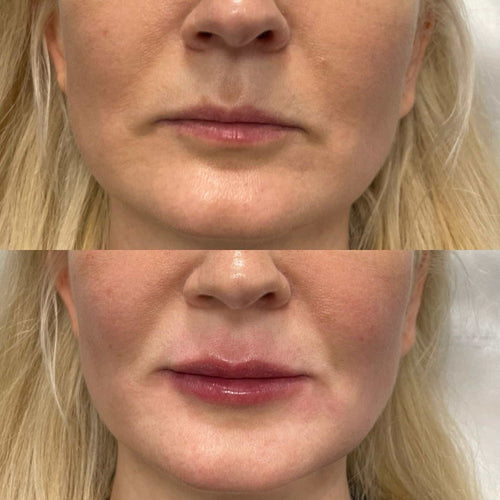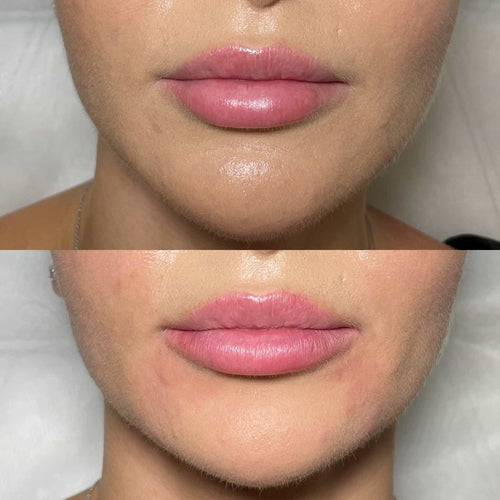Arrange Your Dermal Filler Consultation with Dr. Laura Geige
Factors Influencing Filler Lifespan
Dermal Filler Composition
Dermal fillers are injectable substances used to smooth wrinkles, add volume to facial contours, and enhance lips.

Understanding factors influencing filler lifespan is crucial for patients seeking natural-looking results and informed decisions regarding treatment frequency.

Several factors contribute to how long dermal fillers last, varying widely from person to person and depending on the specific product used.
One major factor is the type of hyaluronic acid (HA) filler utilized. HA-based fillers are popular due to their biocompatibility and ability to attract and hold water, creating a plumping effect. Different HA formulations have varying molecular weights, affecting their longevity.
Generally, fillers with higher molecular weight tend to last longer as they are less easily broken down by the body.
The injection site also plays a role. Areas of high movement, such as around the mouth or forehead, experience more muscle contractions and friction, leading to faster filler breakdown compared to areas like the cheeks or jawline.
Individual metabolism, skin thickness, and collagen production levels also influence filler lifespan. Individuals with faster metabolisms may experience shorter-lasting results, while those with thicker skin might see fillers persist longer.
Lifestyle factors can contribute to filler longevity. Sun exposure accelerates hyaluronic acid degradation. UV radiation damages the collagen and elastin fibers that support the skin, further impacting filler effectiveness.
Smoking has a similar detrimental effect on both skin health and filler lifespan.
Dermal fillers are composed of various materials, each with distinct characteristics affecting their longevity.
Hyaluronic acid (HA) is the most common ingredient due to its safety profile, biocompatibility, and reversible nature. HA fillers can be broken down naturally by the body or dissolved with an enzyme called hyaluronidase.
Calcium hydroxylapatite (CaHa) is another popular option, providing a longer-lasting effect than some HA fillers. It stimulates collagen production, contributing to long-term volumization.
Poly-L-lactic acid (PLLA) fillers are synthetic and gradually degraded over time, stimulating collagen production for lasting results.
It’s important to consult with a qualified medical professional to determine the most appropriate filler type and treatment plan based on individual needs and goals.
Injection Technique & Placement
Determining how long a filler will last on your face involves understanding various factors that influence its longevity, including:
**Filler Type:**
• Different fillers are formulated with varying compositions and densities. Some, like hyaluronic acid (HA) fillers, tend to be naturally broken down by the body more quickly than others.
• Fillers made from poly-L-lactic acid (PLLA) or calcium hydroxylapatite stimulate collagen production, leading to a longer-lasting effect.
**Injection Technique & Placement:**
• Proper injection technique is crucial for optimal results and longevity. Injecting too superficially can lead to premature breakdown or migration of the filler.
• Deep placement within targeted areas helps ensure the filler remains in position and maintains its shape over time.
**Individual Factors:**
• Age: Skin elasticity and collagen production naturally decline with age, potentially shortening filler lifespan.
• Metabolic Rate: Individuals with faster metabolisms may break down fillers more quickly.
• Lifestyle Habits: Sun exposure, smoking, and excessive alcohol consumption can accelerate filler breakdown.
**Facial Anatomy:**
Areas of the face with thinner skin or more dynamic muscle movement might see fillers break down faster.
Here are some general estimates for filler longevity:
- Hyaluronic Acid Fillers: 6-18 months.
- PLLA Fillers: 12-24 months or even longer.
- Calcium Hydroxylapatite Fillers: 12-18 months.
It’s essential to consult with a qualified and experienced injector for personalized advice. They can assess your individual needs, discuss different filler options, and provide realistic expectations regarding longevity.
Individual Metabolism & Lifestyle
Dermal filler lifespan varies significantly from person to person and depends on a multitude of factors.
One crucial factor is the type of filler used. Hyaluronic acid (HA) fillers, the most common type, are naturally broken down by the body’s enzymes over time. Some HA fillers, like those with higher concentrations or cross-linking, tend to last longer than others.
Individual metabolism plays a significant role in how long fillers remain visible. People with faster metabolisms may see their fillers break down more quickly than individuals with slower metabolisms.
Lifestyle choices also influence filler longevity. Sun exposure can break down hyaluronic acid, leading to faster degradation. Smoking can constrict blood vessels, hindering the delivery of nutrients and oxygen to the injection site, which can affect filler absorption and lifespan.
Facial expressions, particularly frequent frowning or smiling, can compress fillers, making them appear less defined over time.
Proper aftercare instructions provided by a qualified practitioner are essential for maximizing filler lifespan. Avoiding excessive sun exposure, smoking, and rubbing the treated area can help preserve the results.
While some fillers may last up to two years, most HA fillers typically require touch-up appointments every six months to a year to maintain their desired effects.
Expected Results: Timelines for Filler Effects
Common Fillers and Their Duration
Filler results are temporary, not permanent. Their longevity depends on several factors, including the type of filler used, individual metabolism, skin elasticity, and lifestyle choices like sun exposure.
Expected Results Timelines for Filler Effects:
Most fillers typically last between 6 months to 2 years. However, certain types can provide longer-lasting results. Let’s break down the durations of common fillers:
-
Hyaluronic Acid Fillers (e.g., Juvederm, Restylane):** These are the most popular and commonly used fillers. They add volume and hydration to the skin and typically last 6 months to a year.
-
Calcium Hydroxylapatite (CaHA) Fillers (e.g., Radiesse):** This type of filler stimulates collagen production, leading to longer-lasting results. It can last up to 18 months or even longer in some cases.
-
Poly-L-Lactic Acid (PLLA) Fillers (e.g., Sculptra):** This type of filler is designed to gradually stimulate collagen growth, providing subtle volume enhancement that lasts up to 2 years or more.
It’s important to note that these are just general guidelines. The actual duration of your filler results will vary depending on the factors mentioned earlier. Regular touch-up appointments are typically recommended to maintain the desired appearance.
Ultimately, a qualified and experienced injector can assess your individual needs and recommend the most suitable filler type and treatment plan for you, helping you achieve your desired aesthetic goals and timeline.
Boosting Longevity with Proper Care
When it comes to facial fillers, their effects are generally temporary and depend on several factors, including the type of filler used, individual metabolism, lifestyle choices, and the treated area.
Different fillers have varying lifespans. For example, hyaluronic acid (HA) fillers tend to last from 6 months to 2 years, while volumizing fillers based on poly-L-lactic acid (PLLA) can provide results for up to 2 years or more.
It’s important to note that these are general estimates. Factors like sun exposure, smoking, and facial expressions can all influence the longevity of filler results.
Proper skin care after a filler treatment is crucial for maximizing its duration and minimizing potential complications. This includes protecting the treated area from the sun with sunscreen, avoiding excessive facial massages or rubbing, and staying hydrated.
Regular touch-up appointments are necessary to maintain the desired results. The frequency of these appointments depends on the individual and the type of filler used. Some people may need touch-ups every 6 months, while others can go a year or more between treatments.
While fillers can temporarily improve facial appearance by addressing wrinkles, volume loss, and other signs of aging, they do not directly contribute to increased lifespan.
Boosting longevity involves a holistic approach that encompasses healthy lifestyle choices, including a balanced diet, regular exercise, adequate sleep, stress management techniques, and avoiding harmful substances like smoking.
Maintaining Youthful Radiance: Follow-Up Treatments
Recommended Frequency for Refills
Maintaining youthful radiance after filler treatments involves understanding the natural degradation process and incorporating follow-up appointments into your skincare regimen.
Fillers, primarily composed of hyaluronic acid, attract and hold water molecules, plumping up areas and diminishing the appearance of wrinkles and fine lines. Over time, these fillers are gradually broken down by the body’s enzymes.
The duration a filler lasts varies depending on several factors, including the type of filler used, the area treated, individual metabolism, and lifestyle choices such as sun exposure and smoking.
Generally, hyaluronic acid fillers can last anywhere from 6 months to 2 years. Some newer formulations, designed for longer-lasting results, may provide up to 3 years of noticeable improvement.
To maintain the youthful volume and smoothness achieved with fillers, follow-up treatments are recommended. These “refill” appointments typically occur when the initial effects begin to fade.
Book a Dermal Filler Consultation at It’s Me and You Clinic with Dr. Laura Geige
For most hyaluronic acid fillers, a refill appointment is scheduled around 6 months after the initial treatment. This allows for a gradual decline in the filler’s volume rather than a sudden drop that can be more noticeable.
It’s important to consult with a qualified and experienced injector to determine the optimal frequency for your specific needs. They will assess your individual circumstances, skin type, desired results, and potential complications to create a personalized treatment plan.
Remember that maintaining youthful radiance is an ongoing process. While fillers can significantly enhance your appearance, they are not a permanent solution. A comprehensive skincare regimen, including sun protection, hydration, and healthy lifestyle choices, complements filler treatments for lasting results.
The Importance of Regular Consultations
Maintaining youthful radiance after aesthetic treatments like dermal fillers requires a commitment to follow-up care and regular consultations with a qualified provider.
Follow-up treatments help ensure long-lasting results. Fillers gradually degrade over time, and touch-up appointments are essential to maintain their volumizing effects and prevent sagging or wrinkles from reappearing. The frequency of these touch-ups varies depending on the type of filler used, individual metabolism, and lifestyle factors like sun exposure.
Regular consultations with a qualified injector are crucial for several reasons. Firstly, they allow your provider to assess the results of your previous treatments and determine the best course of action for future appointments. They can also address any concerns or questions you may have about your appearance or the treatment process.
During these consultations, your provider will evaluate your skin’s condition, identify any new areas of concern, and tailor a personalized treatment plan that meets your individual needs. This might involve adjusting filler placement, volume, or type, or incorporating additional treatments like Botox or microneedling to enhance your results.
Regular communication with your provider also allows them to monitor for any potential complications or side effects associated with fillers. Early detection and intervention can minimize risks and ensure optimal outcomes.
In essence, by following up with your injector and engaging in open communication, you invest in the longevity of your results and maintain a youthful, refreshed appearance over time.
Book a Dermal Filler Consultation at It’s Me and You Clinic with Dr. Laura Geige
Alkhemist LA Plinr Fringe Beverly Hills Apples and Pears Co.
- Juvederm Volite Skin Booster Treatments Near Leigh, Surrey - May 3, 2025
- Can Kratom Energy Drinks Help With Focus At Work? - May 3, 2025
- How Is Tear Trough Filler Done - May 2, 2025
